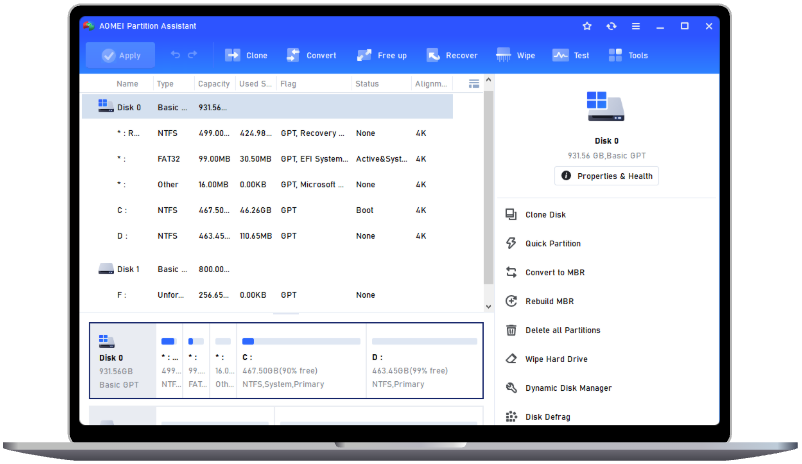Fixed: USB Drive Unusable Unformattable and Reporting 0 Bytes Capacity
A simple format can generally fix the USB drive unusable unformattable and reporting 0 bytes capacity. If you lost data dut to this issue, this post helps you recovery data as well.
Why is the USB drive unusable, unformattable, and showing 0 bytes?
A USB flash drive is a compact and convenient device used for storing, transferring, and backing up files. However, sometimes it may become unusable, unformattable, or display 0 bytes of capacity. This issue can make data inaccessible and prevent normal usage. It is better to understand the possible causes can help you fix it effectively. And here’s a table summarizing the common reasons for a USB drive showing 0 bytes and their solutions:
| Cause | Description | Solution |
|---|---|---|
| Damaged Master Boot Record (MBR) | The MBR is required for the USB to function. If corrupted, the drive may show 0 bytes. | Use an MBR repair tool to fix the issue. |
| Incomplete Formatting Process | If formatting was interrupted or failed, the USB might not display its correct capacity. | Reformat the USB drive. |
| Bad Sectors on the Drive | Frequent use or improper ejection can cause unreadable bad sectors. | Run chkdsk X: /r in Command Prompt (replace "X" with your USB drive letter). |
| Physical Damage | Dropping, bending, or moisture exposure can damage internal components. | Repair the circuit board or replace the USB drive. |
| Virus Infection | Malware can corrupt the file system, making the USB unreadable. | Scan and remove the virus with reliable antivirus software. |
| Power Surges | Electrical spikes can damage the USB’s internal circuits. | Use a power surge protector to prevent damage. |
| Unsafe Removal | Unplugging without using "Safely Remove Hardware" can cause errors. | Always eject the USB properly before disconnecting. |
| RAW File System | If the file system becomes RAW, Windows may not recognize it. | Convert the file system back to NTFS or FAT32 using Disk Management. |
This table makes the causes and solutions clearer and easier to reference. If your USB drive shows 0 bytes, there is no need to worry. Please try to identify the cause and apply the appropriate solution. If data recovery is required, it is best to avoid writing new data to the drive and use specialized recovery software. Additionally, handling your USB drive with care and maintaining regular backups can help prevent such issues in the future.
How to fix USB drive unusable unformattable and reporting 0 bytes capacity?
Fix 1. Format the USB
Formatting is the most effective way to fix a USB drive that is unusable, unformattable, or showing 0 bytes. It resets the file system, repairs corruption, and reallocates storage space, making the drive usable again. This method is especially useful for new disks or those without important data.
However, if the USB has bad sectors, is write-protected, or has a RAW file system, standard formatting may not work. In such cases, a powerful format tool can help bypass these limitations. AOMEI Partition Assistant, a reliable disk manager for Windows 11/10/8/7, offers advanced formatting options. It supports multiple file systems, including FAT32, NTFS, Ext2, Ext3, Ext4, and exFAT, allowing you to format various drives based on your needs.
The Best Windows Disk Partition Manager and PC Optimizer
Step 1. Download this powerful software, install and run it. In the main interface, right-click the target drive and select “Format Partition”.
Step 2. In this small window, specify the file system of the drive based on your own demand and click “OK”.
Step 3. Preview the operation. Then, click “Apply” and “Proceed” to perform it.
Tip: This tool can also format BitLocker drive without password.
Fix 2. Repair bad sectors on USB drive
To repair possible bad sectors on USB drive, you can use CHKDSK.exe tool in the Command Prompt window.
Step 1. Open Command Prompt Windows as you do in solution 2.
Step 2. Input the command (chkdsk g: /f /r /x) and hit on “Enter” to check and repair disk errors.
“g”: stands for the drive letter of the partition you need to check.
“f”: tells CHKDSK to fix any errors it finds.
“r”: tells it to locate the bad sectors on the drive and recover readable information.
“x”: forces the drive to dismount before the process starts.
Fix 3. Update the USB driver or reinstall the USB in Device Manager
Outdated USB driver will also cause USB drive unusable, unformattable, or showing USB drive no media 0 bytes. You can update or reinstall it to fix the issue.
Step 1. Enter into Device Manager by selecting the "Start" button, typing "Device Manager", and select it from the list of results. Expand the category with the hardware you want to update, then right-click it to select "Properties". Go to "Driver" tab, and select "Update Driver".
Step 2. Or select Uninstall to uninstalled USB, then removed it from your computer and plugged back after a while.
Fix 4. Fix damaged MBR of the USB drive
If the Master Boot Record (MBR) is damaged, the system may fail to recognize the USB drive, causing it to appear as unallocated or show 0 bytes. Since the MBR is crucial for identifying and accessing the drive, repairing it can restore normal functionality.
Improper actions, such as removing the USB drive while it is in use, can corrupt the MBR. In such cases, rebuilding the MBR using AOMEI Partition Assistant can help. This tool is compatible with both 32-bit and 64-bit versions of Windows 11/10/8/7 and can effectively fix MBR-related issues.
The Best Windows Disk Partition Manager and PC Optimizer
Step 1. Download the software, install and run it on a Windows computer. In its main interface, right-click the USB drive and choose “Rebuild MBR”.
Step 2. In the dialogue box, choose a proper MBR type for your OS.
Step 3. Back to the main interface and click “Apply” and "Proceed" to execute the operation.
Further reading: How to recover lost data due to the USB problems?
If your USB drive (or other storage devices like hard drives, SD cards, and pen drives) shows 0 bytes of used and free space and asks you to format it, you might consider doing so. But what if the drive contains important data and formatting isn’t an option?
When a USB drive becomes unusable, unformattable, or reports 0 bytes, data loss is a serious risk. AOMEI Partition Assistant can help recover lost files. It supports over 1,000 types of data, including documents, photos, videos, audio files, emails, and compressed files, from HDDs, SSDs, USB drives, and SD cards. It can also restore deleted files, even if they are no longer in the Recycle Bin, or fix the Recycle Bin deleted files automatically on Windows 11/10/8/7.
If your USB drive is experiencing this issue, recovering lost data should be your first step. Keep reading to learn how to restore missing files from a 0-byte USB flash drive.
The Best Windows Disk Partition Manager and PC Optimizer
Step 1. Open the multifunctional software. Locate and click on the options labeled "Recover" and "Recover Data".
Step 2. Identify the partition where the lost files were originally stored. Initiate the scanning process by clicking on "Start Scan".
Step 3. A comprehensive list of deleted files will appear. Select the specific files you want to recover and click on the "Recover" button.
Step 4. Choose a destination folder path to save the recovered files. Proceed by clicking on "Select Folder".
Step 5. Once you see the window below, it indicates that the lost files have been successfully recovered. Simply click "OK" to finish the task.
To sum up
A USB drive unusable unformattable and reporting 0 bytes capacity can be caused by various issues, including MBR corruption, bad sectors, or file system errors. Fortunately, solutions like formatting, repairing bad sectors, updating drivers, or rebuilding the MBR can help restore its functionality. However, if important data is at risk, data recovery should be your first priority.
AOMEI Partition Assistant provides a comprehensive solution for both repairing USB issues and recovering lost data. With its powerful tools, you can fix corrupted drives, reformat storage devices, and retrieve lost files effortlessly. To prevent future problems, always handle your USB drive properly and maintain regular backups.


